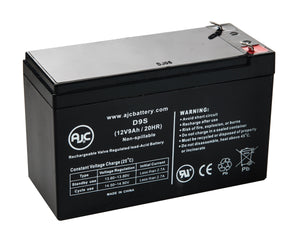SLA Battery Sulfation
What is SLA Battery Sulfation and What Can I Do About it?
Sulfation is a common issue with Sealed Lead-Acid (SLA) batteries, occurring when lead sulfate crystals accumulate on the battery plates. This buildup can reduce the battery's capacity and overall performance. On SLA batteries, most of the sulfation occurs internally as sulfate gets deposited as thin layers on the plates. These thin layer deposits get reversed during charging however, some trace amounts can remain which impact the ability to fully charge your battery. Fortunately, there are steps you can take to limit and even reverse sulfation and extend the life of your SLA batteries.
Materials Needed:
Battery Charger - Choose a charger with a desulfation mode or a pulse mode. This mode sends short bursts of high-voltage energy to break down sulfate crystals.
Water - Some SLA batteries have removable caps, but most do not. For those will removable caps you may need to top off the electrolyte levels with distilled water. For those without, you’ll need some warm water for rinsing.
Safety Gear - Wear protective gear, including gloves and safety glasses, to protect yourself from any unwanted chemicals.
Battery Hydrometer - This tool helps measure the specific gravity of the electrolyte, indicating the state of charge and the condition of the battery.
Battery Load Tester - Use this to assess the battery's overall health and performance.
Step-by-Step Guide to removing SLA Battery Sulfation:
- Safety First:
Ensure you are in a well-ventilated area. Wear appropriate safety gear to protect yourself from chemicals.
- Inspection:
If your SLA battery has removable caps, check the electrolyte levels. Top off with distilled water if necessary. Do not overfill. If it does not, visually inspect the battery if you can see if any sulfation build-up exists on the exterior. More often than not, it builds up around the terminals. Pour warm water over to remove.
- Charge the Battery:
Connect the battery charger to the battery according to the manufacturer's instructions.
If your charger has a desulfation mode, use it. Otherwise, a low and slow charge can also help break down sulfation.
- Monitor Charging:
Keep a close eye on the charging process. If the battery becomes excessively hot, disconnect the charger immediately.
- Perform Equalization Charge (Optional):
Some chargers have an equalization mode that applies a higher voltage to the battery. This can help balance cell voltages and further break down sulfation.
- Test the Battery:
After charging, use a battery load tester to assess the battery's capacity and overall health. Replace the battery if it fails the load test.
- Regular Maintenance:
To prevent future sulfation, consider implementing regular maintenance charging. This involves keeping the battery on a trickle charge when not in use.
- Battery Desulfators:
Consider using a commercial battery desulfator. These devices are designed to break down sulfate crystals and can be connected to the battery for ongoing maintenance.
- Dispose of Old Batteries Properly:
If the battery does not respond to the desulfation process and tests poorly, it may be time to replace it. Be sure to dispose of old batteries in accordance with local regulations.
Summary
Regular maintenance and proper charging techniques can help prevent and mitigate sulfation in SLA batteries. By following these steps, you can extend the life of your batteries and maintain their optimal performance. Always refer to the manufacturer's guidelines for specific charging and maintenance instructions for your SLA battery.
Find Your Replacement Battery
Browse our website to see if we have a match for your replacement battery
Browse Batteries

